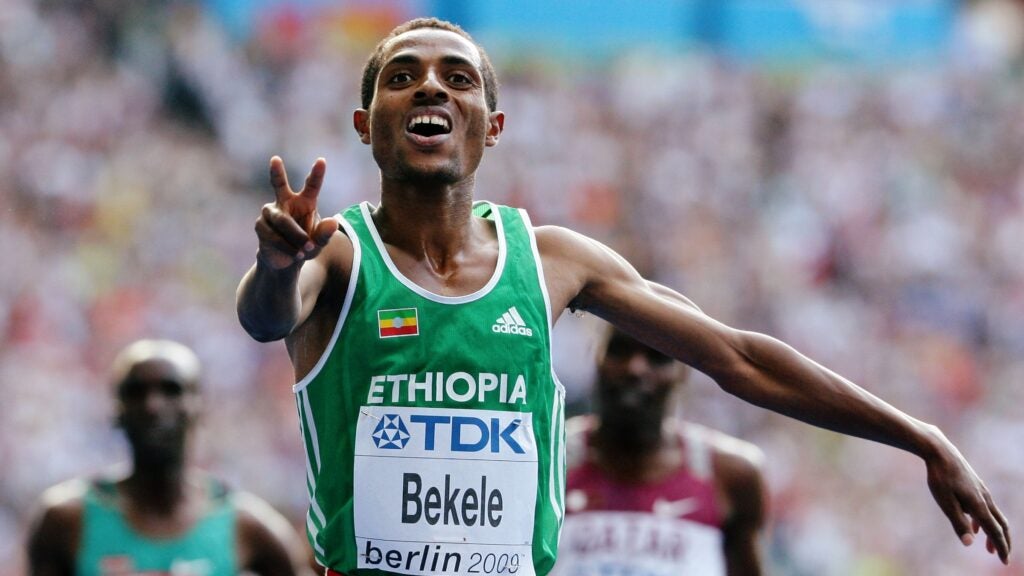World
It’s Easier Than Ever to Set a Running World Record. But Is That Fair?

At the 2008 World Cross Country Championships in Edinburgh, Scotland, a few miles into the senior men’s 12K race, Kenenisa Bekele’s shoe came off. I was in that race, and I remember hearing the announcer’s breathless play-by-play of the incident and thinking, “Wow, I might actually get to be in front of the GOAT in a race!” Alas, it was not to be. Bekele stopped, undid his dislodged shoe, pulled it back on, re-tied it, and set off again. I never even got within sight of him, and he went on to notch his record-extending 11th individual cross country gold medal.
By that time, the Ethiopian superstar already held the track world records over 5,000 and 10,000 meters. Later that summer, he won both events at the 2008 Beijing Olympics. He was at the height of his powers, and few would have disputed that he was the greatest long-distance runner the world had ever seen. Since then, though, Uganda’s Joshua Cheptegei has broken both of Bekele’s track world records, and Kenyan Eliud Kipchoge’s rise as the philosopher-king of the marathon has brought him greater renown than Bekele ever received. Bekele’s current place in the pantheon is unclear—and he doesn’t think that’s fair.
In a recent issue of the Journal of Applied Physiology, Bekele teamed up with two scientists, Borja Muniz-Pardos and Yannis Pitsiladis, and an elite Spanish runner named Carlos Mayo, to author a peer-reviewed editorial titled “Technological Advances in Elite Sport: Where Does One Draw the Line?” Bekele and his co-authors delve into the debate about technology and fairness that has been simmering ever since Nike’s carbon-plate-equipped Vaporfly running shoes helped Kipchoge collect his first Olympic title in 2016, and raise new concerns about the recent introduction of automated pacing lights along the inside rail of the track that help runners lock into a metronomically even pace–which, as it happens, Cheptegei used to break Bekele’s world records.
Debates about technology in sport aren’t new, but they’re once again topical as the Olympic Games in Paris approach. I’m already getting press releases about how the latest generation of advanced running shoes and track spikes will give their wearers an edge. And pundits are debating how runners like Jakob Ingebrigtsen, the superstar Norwegian miler who is seemingly unbeatable when chasing automated pacing lights, will fare in Paris since pacing lights aren’t permitted in championship races. Hearing from Bekele, who at the age of 42 will be competing in next month’s Olympic marathon two decades after his first Olympic gold, is an unexpected twist. At first blush, his complaints might seem like sour grapes from an eclipsed champion, but the issues he raises are ones that we’ll be confronting more and more frequently as technology continues to advance.
Evolution vs. Revolution in Sports Tech
The basic argument that Bekele and his co-authors make is that recent technological advances alter the sport “well beyond any reasonable evolutionary step.” Sure, change happens, but it’s supposed to be gradual. The three key examples they cite are the introduction of supershoes in road racing in 2016, the subsequent advent of superspikes on the track a few years later, and the recent debut of WaveLight pacing lights. Such pacing lights were briefly used by a breakaway pro track league in the 1970s, but were then banned until World Athletics rewrote the rules in 2018 to permit them in non-championship races. The researchers present a graph contrasting the somewhat uneven lap-by-lap pacing in Bekele’s 5,000 and 10,000 track world records with the super-smooth WaveLight-paced splits of Cheptegei’s records (which I previously wrote about here). The resulting advantage is so large, they argue, that separate records should be kept for technology-assisted records, marked by an asterisk, much as there are separate records for women’s-only and mixed races.
Not everyone agrees, of course. The Journal of Applied Physiology has already published a response from Brad Wilkins, the University of Oregon professor who spearheaded Nike’s tech-heavy Breaking2 marathon project in 2017, and physiologist Michael Joyner. Their basic argument is that the ideal of gradual change—of evolution rather than revolution—has always been a myth when it comes to innovation in sport. The history of most sports is filled with periods of sudden and dramatic progress interspersed with long periods of seeming stability. The men’s marathon record, for example, was broken six times between 1963 and 1967, improving by 4 percent over that period—a rate of progress that dwarfs the 2 percent improvement since the advent of supershoes. The innovation that enabled this leap, according to Wilkins and Joyner? The widespread adoption of high-mileage training
What History Tells Us About Track World Records
The truth is that there’s a long list of historical examples that either side of the debate can cite: super swimsuits that were eventually banned, klapskates that weren’t, the transition from bamboo to aluminum vaulting poles, and so on. The most interesting one here, to my mind, is the parallel between the use of human pacers and the use of pacing lights. In Bekele’s paper, human pacing is taken for granted as a normal thing: “the use of a pacemaker to assist with even-paced running during record attempts has historically been universal in athletics,” they write. But that’s only true for recent history. Roger Bannister’s use of human pacemakers to break the four-minute mile in 1954 was enormously controversial at the time. The British Amateur Athletics Board actually tried to ban the use of pacemakers two years later, though the rule proved impossible to enforce.
What, then, is the difference between Bannister’s use of pacemakers in 1954 and Cheptegei’s use of WaveLight in 2020? As far as I can tell, it’s a difference of degree not kind—a matter of social convention. Both men used new and unfamiliar ways of achieving the longstanding goal of pacing their races as evenly as possible. Does that mean that WaveLight was inevitable? Not necessarily. External pacing aids were banned until World Athletics specially approved them in 2018. It would have been perfectly reasonable to decide to leave them banned, but World Athletics apparently felt that allowing them would enhance rather than detract from the sport. The idea, I assume, was that fans are mostly interested in how fast an athlete can run, not in how evenly they can self-pace (or in how much money they can afford to spend on hiring the very best human pacemakers).
Whether that’s really what fans want is difficult to determine. Some do and some don’t, presumably, but cycling’s one-hour record offers a cautionary tale. In 1997, alarmed by the rapid advances in bike technology, cycling authorities instituted two separate categories, much as Bekele et al. propose for WaveLight-paced records. One category restricted riders to the bike technology available when Eddy Merckx set his iconic hour record in 1972; the other category permitted modern equipment. The rule change effectively killed interest in the hour record for nearly two decades: no one wanted to race on a 1972 bike, but no one wanted to try to set an asterisked record either. In 2014, cycling authorities scrapped the separate categories, which reignited interest in the challenge: eight men and six women have set new hour records since 2014.

The Ethics of Sports Tech
A few years ago, when I was writing an article about the potential performance-enhancing benefits of electric brain stimulation, I interviewed an ethicist named Thomas Murray about the role of technology in sport. He made two key points. The first is that the greatest potential for unfairness exists during periods of transition. If nobody has supershoes or everybody has supershoes, the playing field is level either way. The travesty of Eliud Kipchoge’s 2016 Olympic win isn’t simply that he had supershoes; it’s that most of his rivals didn’t. If there’s a prime directive that sports governing bodies should follow, it’s to ensure that whatever innovations are permitted, they’re accessible to all competitors.
A level playing field isn’t the only consideration, though. Even if everyone has access to a new technology, Murray told me, we should also consider how that technology affects the essential characteristics of the sport. Does it change the things athletes have to do, and the qualities they have to possess, to win? There are endless debates about whether supershoes favor some runners more than others, perhaps depending on their weight or their footstrike. Overall, though, I don’t think supershoes change what it takes to win a footrace. Pacing lights are a little different: they lessen the value of having great internal pace sense. So I can see the argument for banning or asterisking them; but I can’t see the argument for banning them while permitting human pacemakers. My own feeling, after a few seasons of watching WaveLight-driven races, is that they add more to the spectator experience than they subtract.
In practice, athletes are remarkably quick to adapt to new realities. I exchanged emails with Carlos Mayo, one of Bekele’s co-authors and a medical doctor who recently started a PhD in sports science. His best half-marathon of 59:39, set last fall in Valencia, is the Spanish record. He ran it in Adidas supershoes. He ran his 10,000-meter track best with WaveLight. These are the current realities of elite sport. Despite what he co-wrote in the Journal of Applied Physiology, he’s not tempted to try racing in old shoes, Eddy Merckx-style, just to see how he would stack up against previous generations—largely, he says, because it’s easier to recover and avoid injury in the new shoes.
As for Bekele, he remains my pick for the greatest all-around men’s distance runner in history. His records have been eclipsed, but I don’t need any asterisks to denote what technology was or wasn’t in common use when he was at his best. As I found out in that cross-country race in Edinburgh, Bekele’s greatness transcended what was on (or off) his feet.
For more Sweat Science, join me on Threads and Facebook, sign up for the email newsletter, and check out my book Endure: Mind, Body, and the Curiously Elastic Limits of Human Performance.










